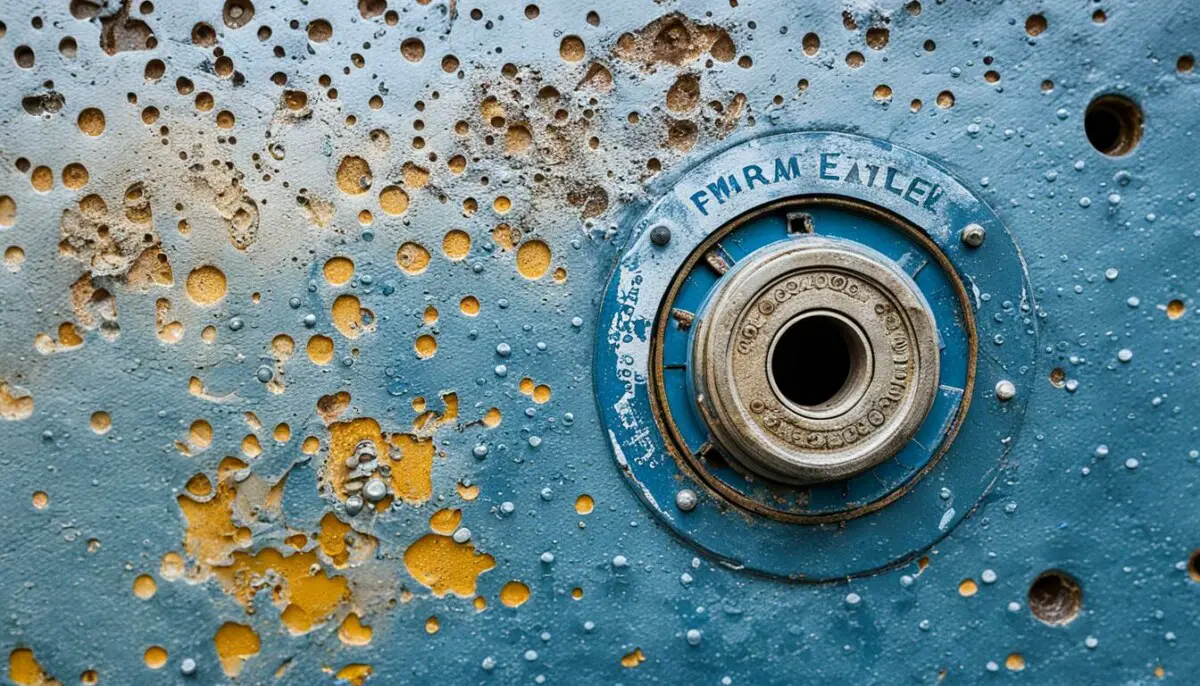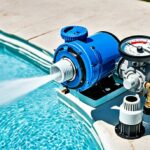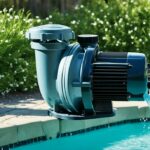Last Updated on 3 months by Francis
When it comes to pool pumps, many pool owners wonder whether these essential pieces of equipment can withstand exposure to water. After all, pool areas are often subject to rain and splashes from swimmers. In this article, we will explore the question: Can pool pumps get wet?
Most pool pumps are designed to handle light exposure to water, such as rain and splashes. However, they are not meant to be submerged in standing water or exposed to heavy rainfall for extended periods. Submerging a pool pump or running it during an electrical storm can cause permanent damage and pose safety risks. It’s important to understand the limitations of pool pumps and take necessary precautions to protect them.
Contents
Key Takeaways:
- Pool pumps are designed to withstand rain and splashes, but not immersion in standing water or exposure to heavy rainfall.
- Running a pool pump during an electrical storm or lightning poses safety risks and can cause permanent damage.
- Proper maintenance and regular monitoring of the pump are crucial to ensure smooth operation and prevent water damage.
- Take necessary precautions in areas prone to flooding and ensure proper drainage to protect the pool pump.
- Consult the manufacturer’s guidelines for specific recommendations on using the pool pump during rain and inclement weather.
When is it not safe to run the pool pump in the rain?

While it is generally safe to run the pool pump in the rain, there are certain scenarios where it may not be advisable. Pool pumps are designed to be water-resistant and can handle rain and splashes without issues. However, they are not meant to be submerged in water or exposed to prolonged heavy rain. To ensure the safety and longevity of your pool pump, it’s important to consider the following factors:
- Drainage issues: If your pump’s location has poor drainage, it may not be safe to run the pump during heavy rain. The accumulation of water around the pump can lead to submersion, which can damage the pump and affect its performance.
- Flooding risk: If your pump is at risk of flooding due to its location or nearby water sources, it’s best to unplug the pump before rainfall and switch it off at the breaker. This precautionary measure can help avoid water damage and potential electrical hazards.
- Electrical thunderstorm: During an electrical thunderstorm, it is crucial to switch off and unplug the pool pump, along with all outdoor electrical devices. Lightning strikes can cause power surges and irreparable damage to the pump.
It’s important to follow the manufacturer’s guidelines regarding rainwater safety for your specific pool pump model. If unsure, consult the pump’s user manual or contact the manufacturer for further information.
Remember, proper maintenance and precautions are essential to prevent water damage and ensure the smooth operation of your pool pump.
The impact of heavy rains on your pool
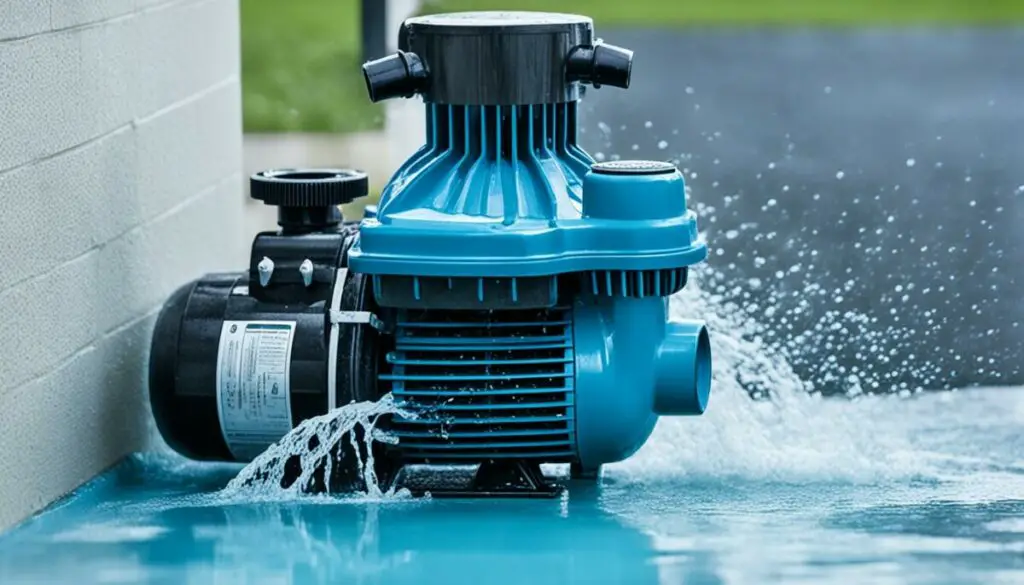
When heavy rains occur, they can have various effects on your pool, necessitating proper maintenance and precautions to protect your pool pump and ensure its optimal performance. Let’s explore the impact of heavy rains on your pool and discuss essential pool pump maintenance and waterproofing measures.
Changes in pH and Alkalinity Levels
One of the effects of heavy rains on your pool is the alteration of pH and alkalinity levels. Rainwater can introduce changes, leading to imbalances that may affect water safety and the effectiveness of chlorine. Regularly checking and adjusting the pH levels of your pool water is crucial to maintain the proper chemical balance and prevent any damage to your pool pump caused by imbalanced water chemistry.
Introduction of Impurities and Contaminants
Heavy rains can also introduce impurities and contaminants into your pool. Rainwater can carry debris, dirt, and pollutants from the surrounding environment, reducing water clarity and quality. Proper filtration and chemical treatment become even more important during and after heavy rainfall to ensure that your pool remains clean and safe for swimming. Running the pool pump during heavy rains aids in circulating and filtering the water, preventing the accumulation of debris and contaminants that could clog the pump and cause damage.
Pool Flooding and Chemical Dilution
If heavy rains cause pool flooding, it can lead to the dilution of water-sanitizing chemicals. The effectiveness of chlorine and other water-treating agents may be reduced, making it more challenging to maintain a healthy pool environment. Additionally, flooded water can spread beyond the pool and contaminate surrounding areas. Running the pool pump, both during and after heavy rains, can minimize the dilution of chemicals and ensure that they are effectively distributed throughout the pool.
Maintaining Water Circulation and Algae Control
Running the pool pump during and after heavy rains is essential for maintaining water circulation. Adequate water circulation helps prevent stagnant areas in the pool, reducing the potential for algae growth. Algae thrive in stagnant water, and controlling their growth is crucial for maintaining clear and healthy pool water. By continuously running the pool pump, you can effectively circulate the water and prevent algae formation.
Preventing Water Damage and Ensuring Pump Performance
Proper maintenance is crucial to prevent water damage to your pool pump during heavy rains. Regular cleaning, checking and adjusting pH levels, shocking the pool, and maintaining chemical balance are all important tasks to keep your pool pump in top condition. Additionally, taking preventive measures such as reducing water levels during heavy rainfall and covering the pump with a tarp or waterproof covering can provide added protection against water intrusion. By diligently following these maintenance practices, you can help protect your pool pump from water damage and ensure its smooth operation.
| Maintenance Task | Importance |
|---|---|
| Regular cleaning of the pump | Prevents debris buildup that can affect pump performance |
| Checking and adjusting pH levels | Maintains the proper chemical balance and water safety |
| Shocking the pool | Controls algae growth and removes contaminants |
| Maintaining chemical balance | Ensures effective water treatment and sanitization |
| Reducing water levels during heavy rainfall | Prevents water damage to the pump and surrounding areas |
| Covering the pump with a tarp or waterproof covering | Provides additional protection against water intrusion |
Ensure that you perform these maintenance tasks regularly to protect your pool pump, improve its longevity, and enjoy a clean and well-maintained pool.
How can you ensure the pool pump is running smoothly?
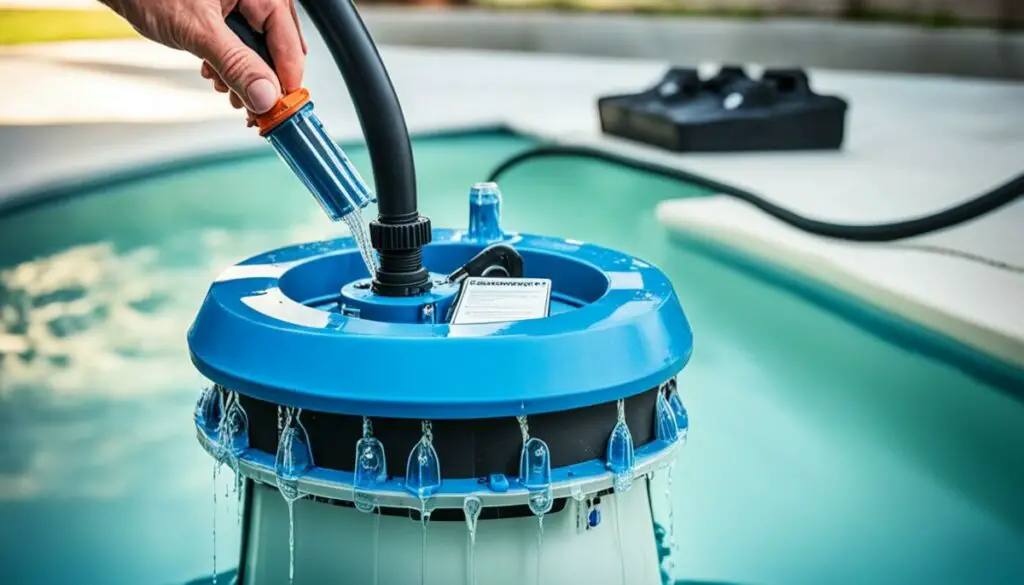
Proper maintenance is crucial to keeping your pool pump running smoothly and efficiently. By following these essential maintenance tips, you can maximize the lifespan of your pump and avoid costly repairs.
Regular Cleaning
One of the most important maintenance tasks for your pool pump is regular cleaning. Make sure to clean the pump strainer and skimmer baskets on a regular basis to prevent debris buildup. This will help ensure proper flow and prevent clogs that can strain the pump’s motor.
Water pH Level
Monitoring and adjusting the pH level of your pool water is essential for maintaining water safety and the effectiveness of chlorine. Test the water regularly using a reliable pool water testing kit and adjust the pH levels as needed. This will prevent corrosion and scale buildup in the pump and other pool equipment.
Chemical Balance
Proper chemical balance is crucial for preventing algae growth, scaling, and staining. Regularly shock the pool to eliminate contaminants and maintain the appropriate chemical balance. Consult your pool’s chemical guidelines and manufacturer recommendations to ensure you are using the correct chemicals in the proper amounts.
Protecting Against Rainwater
During heavy rainfall, it’s important to take steps to protect your pool pump from excess water. Reduce the water level in the pool using the drain or a submersible pump to prevent flooding and water damage. Additionally, covering the pump with a tarp or a waterproof covering can provide added protection against rainwater. Remember to remove the cover once the rain has stopped to allow for proper ventilation.
Electrical Storms
Electrical storms pose a significant risk to pool pumps and other outdoor electrical devices. Before an electrical storm, be sure to switch off the pump at the breaker and unplug it from the power source. This will help protect the pump from power surges and potential damage. It is also advisable to store pool toys and furniture indoors during thunderstorms.
Troubleshooting and Professional Help
If you encounter any issues with your pool pump, such as strange noises, reduced flow, or motor problems, consult the manufacturer’s troubleshooting guide or seek professional help. Regular maintenance and inspections by a qualified pool technician can help identify and fix potential problems before they escalate.
By following these maintenance tips and taking proper precautions, you can ensure the smooth operation and longevity of your pool pump. Regular cleaning, monitoring water chemistry, protecting against rainwater, and being cautious during electrical storms are all essential steps in maintaining your pool pump’s efficiency and performance.
| Maintenance Tips | Benefits |
|---|---|
| Regular cleaning of pump strainer and skimmer baskets | Prevent debris buildup, ensure proper flow |
| Monitoring and adjusting water pH level | Maintain water safety, optimize chlorine effectiveness |
| Maintaining chemical balance | Prevent algae growth, scaling, and staining |
| Protecting against rainwater | Prevent flooding and water damage |
| Switching off pump during electrical storms | Prevent power surges, potential damage |
Is there a waterproof case for pool pumps?
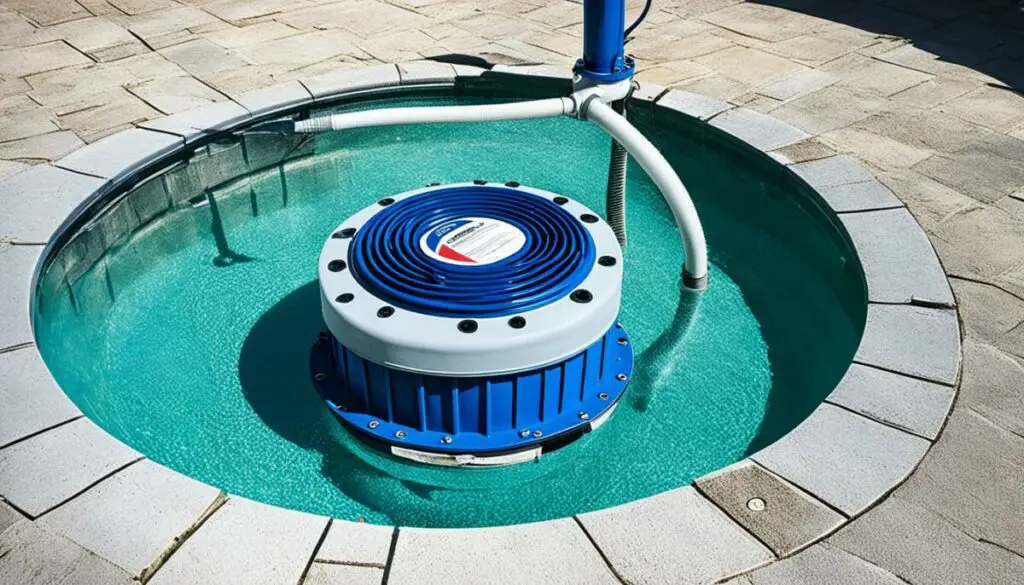
While there are no specific waterproof cases designed for pool pumps, there are alternative options that can provide some level of protection against water. One such option is to use cases that are designed for microphones or insulin pumps, like the Aquapac Microphone Case. These cases offer a degree of waterproofing for the pool pump, helping to shield it from water damage. However, it is important to note that these cases should be checked for proper ventilation and any potential crimping of the tubing, as improper airflow can lead to pump malfunctions.
It is essential to highlight that while these cases can offer some level of protection against water, continuous long-term submersion or extensive exposure to water can still pose a risk to the pump’s functionality. Therefore, it is crucial to exercise caution and avoid prolonged exposure to water to ensure the pump’s longevity and performance.
Alternatively, individuals can consider untethered regimens, which involve using a long-acting insulin to provide basal insulin instead of relying solely on the pump. By reducing reliance on the pump, there is less risk of water exposure and potential damage to the pump. Additionally, exploring pumps that are specifically marketed as waterproof, such as the Omnipod, can provide a reliable solution for those who require a truly waterproof pump.
Advantages of Waterproof Cases:
- Offers protection against water damage
- Provides peace of mind when using the pool pump in wet environments
- Can be a cost-effective solution compared to purchasing a new waterproof pump
Disadvantages of Waterproof Cases:
- May require regular maintenance and ventilation checks
- Not suitable for continuous long-term submersion or extensive water exposure
- Potential risk of pump malfunctions if proper airflow is not ensured
Product Comparison:
| Waterproof Case | Advantages | Disadvantages |
|---|---|---|
| Aquapac Microphone Case | Offers waterproofing for pool pumps | Requires ventilation checks, not suitable for prolonged submersion |
In conclusion, while no specific waterproof cases are designed for pool pumps, alternative options like microphone or insulin pump cases can provide some level of protection against water. However, it is important to exercise caution and avoid prolonged exposure to water to ensure the pump’s functionality. Untethered regimens and exploring pumps marketed as waterproof are additional options to consider when seeking reliable solutions. It is crucial to balance the advantages and disadvantages of using waterproof cases and thoroughly research specific products to make an informed decision.
The reliability of Tandem t:slim X2 pump in water
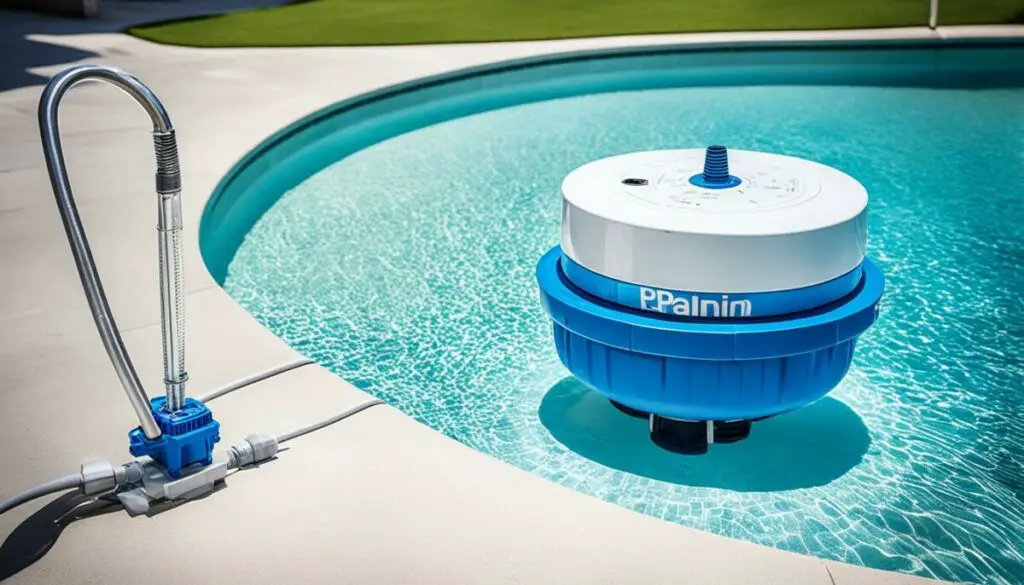
The Tandem t:slim X2 pump is known for its remarkable water resistance, making it a popular choice among users who enjoy water activities, such as swimming. The pump has been certified to be watertight to a depth of 3 feet for 30 minutes, giving users the freedom to engage in various water-based activities without worry.
Many users have reported positive experiences using the Tandem t:slim X2 pump in water, emphasizing its reliability and durability. They have successfully used the pump during swimming sessions and other water-based activities without experiencing any issues or water-related failures.
Tandem Customer Support has further assured users that in the unlikely event of water-related damage, the pump will be replaced under warranty. This provides users with additional peace of mind and confidence in the pump’s resilience against water damage.
However, it is important to note that while the Tandem t:slim X2 pump is designed to be water-resistant, it is crucial to follow the guidelines provided by Tandem to ensure optimal functionality and longevity. To provide added protection during prolonged water exposure, it is recommended to disconnect the pump or use a waterproof case.
Please note: Individual experiences may vary when using electronic devices in water, and it’s always best to consult with the manufacturer and exercise caution.
To illustrate the reliability of the Tandem t:slim X2 pump in water, we have gathered feedback from actual users who have shared their experiences and insights:
“I’ve been using my Tandem t:slim X2 pump during swimming sessions, and it has been absolutely incredible. I’ve had no issues or concerns with water damage. It’s great to have a pump that allows me to enjoy my favorite activities without any restrictions!” – Sarah W.
“I was initially hesitant about using my Tandem pump in water, but after doing some research and talking to Tandem Customer Support, I decided to give it a try. I’ve been swimming with my pump for months, and it has performed flawlessly. It’s definitely water-resistant!” – Michael R.
The positive experiences shared by users reinforce the reliability of the Tandem t:slim X2 pump in water. However, it’s important to remember that results may vary for each individual and the level of water exposure. Consulting with the manufacturer and adhering to their guidelines will help ensure the optimal performance and longevity of the pump.
User experiences with Tandem t:slim X2 pump and water exposure
Users have reported varying experiences with the Tandem t:slim X2 pump and water exposure. Some have used the pump in water activities, including swimming, without any issues or water-related failures. Others have reported pump failures or issues after water exposure, even for brief periods. It is important to note that while the pump is designed to be water-resistant, individual experiences may vary, and not all pumps may perform equally in water. It’s crucial to follow the manufacturer’s guidelines and exercise caution when exposing the pump to water. Using a waterproof case or disconnecting during prolonged water exposure may provide extra protection.
If we take a look at user experiences posted on various forums and online platforms, we can see a range of opinions regarding the Tandem t:slim X2 pump’s performance in water. Let’s explore some of these experiences:
“I’ve used my Tandem t:slim X2 pump while swimming in the ocean and have had no issues. It remained fully functional, and I didn’t experience any water-related failures.”
“I took my pump with me while snorkeling, and it stopped working as soon as it got wet. I had to get it replaced. I would advise being cautious and not exposing it to water for extended periods.”
Individual variation in water resistance
While the Tandem t:slim X2 pump is designed to be water-resistant, it’s important to remember that individual experiences may vary. Some users have reported using the pump in water without any issues, while others have encountered problems after water exposure. This discrepancy could be due to factors such as manufacturing variations and handling differences.
Manufacturer guidelines
Tandem Diabetes Care provides guidelines for using the pump in water. It is recommended to disconnect the pump and store it in a safe, dry place during activities involving prolonged water exposure, such as swimming or taking a shower. Following these guidelines can help minimize the risk of water-related failures.
Moreover, some users have found success by using a waterproof case specifically designed for medical devices. These cases can provide an additional layer of protection against water damage.
Consulting with the manufacturer
If you have concerns or questions regarding the Tandem t:slim X2 pump’s water resistance capabilities, it’s best to consult with the manufacturer directly. They can provide specific guidance based on the pump’s design and technical specifications.
Remember, water exposure can potentially lead to damage or malfunction of the pump, so it’s important to exercise caution and follow the manufacturer’s recommendations to protect your investment and ensure the pump’s continued functionality.
Alternatives for waterproof pumps
While the Tandem t:slim X2 pump is water-resistant, users who require a truly waterproof pump may consider alternatives. One option is the Omnipod system, which is specifically marketed as a waterproof pump. The Omnipod has a built-in, wearable design that eliminates the need for tubing and is suitable for swimming and water activities.
Another alternative is to explore waterproof cases designed for other electronic devices, such as microphones or insulin pumps, that may offer additional waterproofing for the pump. Thorough research and consultation with the manufacturer are crucial to ensuring compatibility and effectiveness when using these alternatives.
For users who require a truly waterproof pump, exploring alternatives such as the Omnipod system or researching pumps with specific waterproof features may be beneficial. Consulting with the manufacturer, reviewing warranties, and considering the reliability of customer support are important factors when making a decision on a pump.
The importance of pump warranty and customer support
When considering the purchase of a pool pump or any electronic device, it is important to review the warranty and customer support offered by the manufacturer. A warranty that covers water-related damage can provide peace of mind and protection in case of pump failures due to water exposure. It is also essential to research the manufacturer’s customer support and their responsiveness to water-related issues and failures. Reliable customer support can help address concerns, provide guidance on proper usage and maintenance, and assist in replacing or repairing pumps that experience water damage.
Conclusion
Pool pumps are essential for maintaining the cleanliness and proper circulation of pool water. While these pumps are designed to be water-resistant, prolonged submersion or continuous exposure to water can pose a risk to their functionality. It is crucial to follow proper maintenance practices to prevent water damage and ensure smooth pump operation.
Regular cleaning of the pump, monitoring pH levels, shocking the pool, and maintaining chemical balance are essential steps to protect pool pumps from water damage. By implementing these practices, pool owners can prolong the lifespan of their pumps and maintain optimal water quality.
While there are no specific waterproof cases for pool pumps, alternative options such as microphone or insulin pump cases may provide additional protection against water. However, it is important to exercise caution and closely follow the manufacturer’s guidelines when exposing the pump to water.
For those in need of a truly waterproof pump, exploring alternatives like the Omnipod system or researching pumps with specific waterproof features can be beneficial. Additionally, consulting with the manufacturer and reviewing warranties can provide further reassurance and support if water damage occurs.
Remember, protecting pool pumps from water is essential for their longevity and performance. By taking the necessary precautions and staying diligent with maintenance, pool owners can enjoy clean and well-circulated water for years to come.
| Conclusion Highlights: |
|---|
| Proper maintenance is crucial to protect pool pumps from water damage and ensure smooth operation |
| Regular cleaning, monitoring pH levels, and maintaining chemical balance are vital for pump longevity |
| While no specific cases are available, alternatives like microphone or insulin pump cases can offer additional protection |
| Exploring truly waterproof pump options and reviewing warranties can provide peace of mind |
References
When it comes to understanding pool pump water damage and the importance of waterproof pool pumps, it’s helpful to explore various sources and user experiences. Here are some valuable references and forum threads where you can find more information:
1. “Should I turn off pool pump when raining?” – Pond Life website.
2. “Is it safe to wear my Tandem t:slim G4 swimming?” – Diabetes Daily forum thread.
3. “Swimming and waterproofing question” – DIY Fish Keepers forum thread.
4. “Water and Tandem connection,” “Question about swimming with T2slim,” and “Waterproof X2?” – TuDiabetes forum threads.
5. “Short term water incidents and ‘waterproofing’ a tandem pump” – Diabetes Ireland forum thread.
These references provide insights and experiences shared by individuals within the diabetes and pool community. Exploring these resources can help you gain a better understanding of pool pump waterproofing and how to prevent pool pump water damage.
FAQ
Can pool pumps get wet?
While most pool pumps are designed to withstand rain and splashes, they are not meant to be submerged in standing water. Running the pump during an electrical storm or lightning can cause permanent damage. It’s important to ensure proper drainage and take precautions in areas prone to flooding. Rainwater can affect the pH and alkalinity of pool water, and it can introduce impurities and contaminants. However, running the pool pump during rain helps circulate and filter the rainwater, control algae, and maintain healthy pool water. Regular maintenance and monitoring of the pump are essential to ensure smooth operation and prevent water damage.
When is it not safe to run the pool pump in the rain?
It is generally safe to run the pool pump in the rain, unless there are drainage issues or the pump is at risk of flooding. Pool pumps are typically waterproof and can handle rain, but they are not designed to be submerged in water. If the pump’s location has poor drainage or is prone to flooding, it is advisable to unplug the pump before rainfall and switch it off at the breaker. It is important to follow the manufacturer’s guidelines regarding rainwater safety. However, in the case of an electrical thunderstorm, it is crucial to switch off and unplug the pump, along with all outdoor electrical devices.
What is the impact of heavy rains on your pool?
Heavy rains can have various effects on a pool. Rainwater can alter the pH and alkalinity levels, leading to imbalances that may affect water safety and chlorine effectiveness. It can also introduce impurities and contaminants into the pool, making filtration and chemical treatment more important. Pool flooding can reduce the effectiveness of water-sanitizing chemicals and cause them to spread into surrounding areas. Running the pool pump during and after heavy rains can help circulate and filter the water, control algae, and maintain water quality. Proper maintenance, including regular cleaning, checking and adjusting pH levels, shocking the pool, and maintaining chemical balance, is crucial to prevent water damage and ensure optimal pump performance.
How can you ensure the pool pump is running smoothly?
Proper maintenance is essential for the smooth operation of the pool pump. Regular cleaning of the pump strainer and skimmer baskets helps prevent debris buildup. Checking and adjusting the water’s pH level is important to ensure water safety and chlorine effectiveness. Shocking the pool and maintaining chemical balance are necessary to control algae and prevent scaling or staining. Using a pool net to keep the pool clean and reducing water levels during heavy rainfall can also help protect the pump. It is important to switch off the pump at the breaker and unplug it before an electrical storm. Covering the pump with a tarp or waterproof covering can provide added protection against rainwater. Additionally, storing pool toys and furniture indoors during thunderstorms is advisable.
Is there a waterproof case for pool pumps?
While there are no specific waterproof cases designed for pool pumps, some options can provide protection against water. Cases designed for microphones or insulin pumps, such as the Aquapac Microphone Case, can offer waterproofing for the pump. These cases may need to be checked for adequate ventilation and potential crimping of the tubing. However, it is important to note that continuous long-term submersion or extensive water exposure can still pose a risk to the pump’s functionality. Other options to consider are untethered regimens, where a long-acting insulin is used to provide basal insulin instead of relying solely on the pump, or exploring pumps that are specifically marketed as waterproof, such as the Omnipod.
What is the reliability of the Tandem t:slim X2 pump in water?
The Tandem t:slim X2 pump is certified to be watertight to a depth of 3 feet for 30 minutes (IPX7 rating). Many users have reported using the pump in water without any issues, including swimming and other water activities. Tandem Customer Support has confirmed that the pump will be replaced under warranty for any water-related damage. However, it is important to follow the guidelines provided by Tandem and ensure that the pump is not submerged for extended periods of time. Disconnecting or using a waterproof case during prolonged water exposure can provide added protection. It’s important to note that individual experiences may vary, and it’s always best to consult with the manufacturer and exercise caution when using electronic devices in water.
What are user experiences with Tandem t:slim X2 pump and water exposure?
Users have reported varying experiences with the Tandem t:slim X2 pump and water exposure. Some have used the pump in water activities, including swimming, without any issues or water-related failures. Others have reported pump failures or issues after water exposure, even for brief periods. It is important to note that while the pump is designed to be water-resistant, individual experiences may vary, and not all pumps may perform equally in water. It’s crucial to follow the manufacturer’s guidelines and exercise caution when exposing the pump to water. Using a waterproof case or disconnecting during prolonged water exposure may provide extra protection.
What are the alternatives for waterproof pumps?
While the Tandem t:slim X2 pump is water-resistant, users who require a truly waterproof pump may consider alternatives. One option is the Omnipod system, which is specifically marketed as a waterproof pump. The Omnipod has a built-in, wearable design that eliminates the need for tubing and is suitable for swimming and water activities. Another alternative is to explore waterproof cases designed for other electronic devices, such as microphones or insulin pumps, that may offer additional waterproofing for the pump. It is important to thoroughly research and consult with the manufacturer to ensure compatibility and effectiveness when using these alternatives.
What is the importance of pump warranty and customer support?
When considering the purchase of a pool pump or any electronic device, it is important to review the warranty and customer support offered by the manufacturer. A warranty that covers water-related damage can provide peace of mind and protection in case of pump failures due to water exposure. It is also essential to research the manufacturer’s customer support and their responsiveness to water-related issues and failures. Reliable customer support can help address concerns, provide guidance on proper usage and maintenance, and assist in replacing or repairing pumps that experience water damage.
Conclusion
Pool pumps are typically designed to be water-resistant and can handle rain and splashes without issues. However, extended submersion or continuous exposure to water may pose a risk to the functionality of the pump. Proper maintenance, including regular cleaning, monitoring pH levels, shocking the pool, and maintaining chemical balance, is crucial to prevent water damage and ensure the pump’s smooth operation. While there are no specific waterproof cases designed for pool pumps, alternatives such as microphone or insulin pump cases may provide additional protection against water. It is important to follow the manufacturer’s guidelines and exercise caution when exposing the pump to water. For users who require a truly waterproof pump, exploring alternatives such as the Omnipod system or researching pumps with specific waterproof features may be beneficial. Consulting with the manufacturer, reviewing warranties, and considering the reliability of customer support are important factors when making a decision on a pump.
References
– “Should I turn off pool pump when raining?” forum thread on Pond Life website
– “Is it safe to wear my Tandem t:slim G4 swimming?” forum thread on Diabetes Daily
– “Swimming and waterproofing question” forum thread on DIY Fish Keepers
– “Water and Tandem connection”, “Question about swimming with T2slim”, and “Waterproof X2?” forum threads on TuDiabetes
– “Short term water incidents and ‘waterproofing’ a tandem pump” forum thread on Diabetes Ireland
– User experiences and insights shared by members of the diabetes community on various online platforms.

